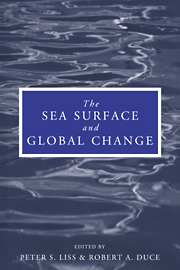Book contents
- Frontmatter
- Contents
- List of contributors
- Preface
- 1 Report Group 1 – Physical processes in the microlayer and the air–sea exchange of trace gases
- 2 Report Group 2 – Biological effects of chemical and radiative change in the sea surface
- 3 Report Group 3 – Photochemistry in the sea-surface microlayer
- 4 Transport processes in the sea-surface microlayer
- 5 The role of organic films in air–sea gas exchange
- 6 Bubbles and their role in gas exchange
- 7 The physical chemistry of air–sea gas exchange
- 8 The sea-surface microlayer and its effect on global air–sea gas transfer
- 9 Chemistry of the sea-surface microlayer
- 10 Biophysics of the surface film of aquatic ecosystems
- 11 Biological effects of chemicals in the sea-surface microlayer
- 12 Neuston of seas and oceans
- 13 Photochemistry in the sea-surface microlayer
- 14 Hydrocarbon breakdown in the sea-surface microlayer
- 15 Applications of laser technology and laser spectroscopy in studies of the ocean microlayer
- 16 Remote sensing of the sea-surface microlayer
- Index
9 - Chemistry of the sea-surface microlayer
Published online by Cambridge University Press: 24 September 2009
- Frontmatter
- Contents
- List of contributors
- Preface
- 1 Report Group 1 – Physical processes in the microlayer and the air–sea exchange of trace gases
- 2 Report Group 2 – Biological effects of chemical and radiative change in the sea surface
- 3 Report Group 3 – Photochemistry in the sea-surface microlayer
- 4 Transport processes in the sea-surface microlayer
- 5 The role of organic films in air–sea gas exchange
- 6 Bubbles and their role in gas exchange
- 7 The physical chemistry of air–sea gas exchange
- 8 The sea-surface microlayer and its effect on global air–sea gas transfer
- 9 Chemistry of the sea-surface microlayer
- 10 Biophysics of the surface film of aquatic ecosystems
- 11 Biological effects of chemicals in the sea-surface microlayer
- 12 Neuston of seas and oceans
- 13 Photochemistry in the sea-surface microlayer
- 14 Hydrocarbon breakdown in the sea-surface microlayer
- 15 Applications of laser technology and laser spectroscopy in studies of the ocean microlayer
- 16 Remote sensing of the sea-surface microlayer
- Index
Summary
Abstract
The last 15 years has seen a considerable increase in our understanding of the chemical composition of the sea-surface microlayer. However, many new developments in methods of chemical analysis have yet to be applied systematically to the microlayer. The development of continuous microlayer samplers coupled to UV absorbance or fluorescence detectors now allows much greater temporal and spatial resolution to be achieved in field measurements, and will have great application with the development of new chemical sensing technology. These techniques, and a greater range of studied environments, indicate that microlayer enrichment of the major classes of organic compounds (protein, carbohydrate) or of organic parameters such as dissolved organic carbon, is less than earlier studies might have indicated. Enrichment factors larger than 1.5 are relatively rare, and depletion is often observed. Improvements in the analysis of specific organic compounds, including better sample blanks, sensitivity and improved identification of individual compounds, have all been seen. Recently-reported concentrations of PCB and organochlorine insecticides in low latitude regions are extremely low, although microlayer samples enriched in these components are found at high latitudes. Organotin species have also been reported in microlayers. For trace elements passively associated with surface-layer organic material such as trace metals, a confusing picture exists.
- Type
- Chapter
- Information
- The Sea Surface and Global Change , pp. 287 - 320Publisher: Cambridge University PressPrint publication year: 1997
- 37
- Cited by



